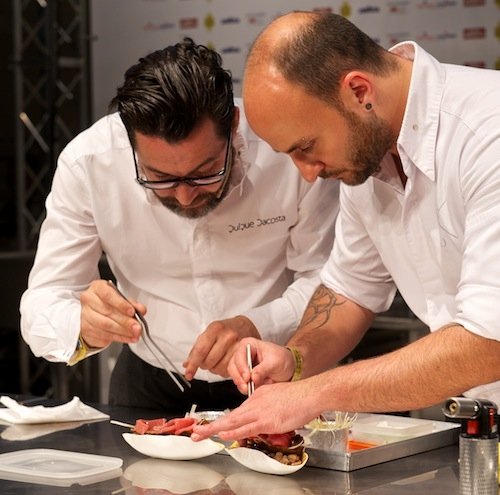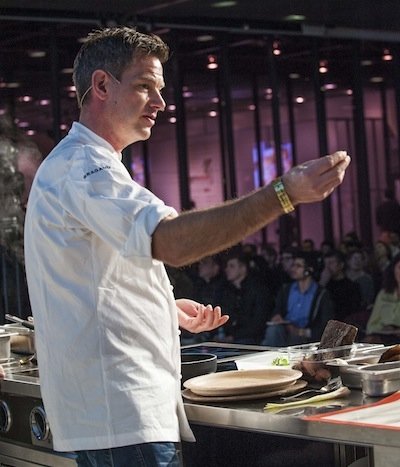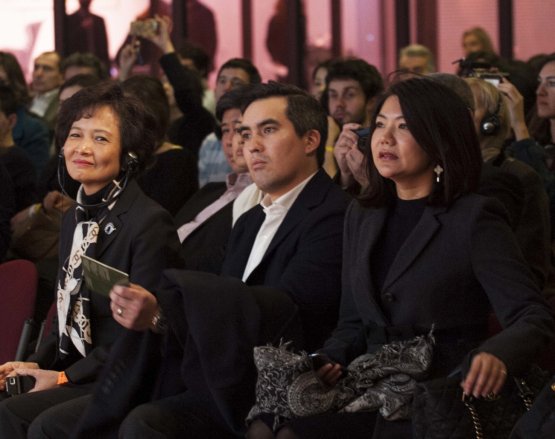Speaking today about globalization is banal, but you have to think about it when facing the incredible speed at which techniques, methods, cultures and culinary traditions end up in the global blender. Identità Golose offered a view of these dynamics. The case of Japanese chef Yoshi Takazawa was emblematic: he presented his “modern version of Italian cuisine”, that is to say an adaptation of our cuisine following his personal interpretation: clams, caponata, caprese, tiramisù, carbonara, the Japanese-style minestrone…
Even Quique Dacosta from Spain explained the influence of our cuisine on his, in particular with regards to his spaghetti alla puttanesca: a mixture of acid Hollandaise sauce out of a pastry bag, in the shape of spaghetti, “seasoned” with pilpil sauce made with dried tomatoes and smoked oregano.

Valencian Quique Dacosta presented his version of Spaghetti alla puttanesca
For quite some time our traditional dishes have inspired, both at home and outside, a total mixing of the cards. To which point, however, is it acceptable to break down a tradition without transforming it into something completely different? I’ve wondered about this many times throughout the three-day-event. Even when
Alessandro Negrini and Fabio Pisani paid their tribute to
Nadia Santini with their tortelli filled with Polignano carrots, cucumber mustard and bitter almonds.
Pisani recalled that this is what
Nadia once did too: having finished the pumpkin, she used carrots instead.
Of course, each chef needs to set his own limits and I believe that many of the young chefs in the auditorium are asking themselves, every day, to which extent they can change. Should they venture with unexplored techniques and ingredients, looking for new flavours, perhaps playing with Thai or Mexican cuisine (as with Enrico Crippa’s new tacos o Quique Dacosta’s Japanese gazpacho)? Or should they defend what’s left of tradition?

Danish chef Henrik Yde, specialised in Thai and Chinese cuisine
It is true,
Massimo Bottura is right: tradition has not that respect for raw materials. But can we amend it without changing its sense? If I add a pumpkin filling to a square of pasta destined to an
agnolino don’t I change the perception of that tortello, and thus its value? We’re all now walking in a supermarket full of global techniques and inspirations in which our local traditions run the risk of being only an exotic touch. After all, we don’t have a different attitude towards other cultures: we try to make foreign dishes with an approximated use of ingredients and following indications that aren’t necessarily faithful to the original version.
Cuisine today goes beyond the traditions of each country. And in every country we are inclined to choose the dishes that can be better adapted according to a universal super-language. Gastronomy is more and more inclusive, in a collision of cultures that opens enormous horizons. If, however, I need to have a glimpse of a close and reassuring future that is the one indicated by chef Jeremy Bearman from New York, in his work side by side with nutritionist Kristy Del Coro.
If nothing else, they build their cuisine on totally Mediterranean foundations, in which the choice of each ingredient is based on unquestionable dietician and nutritional motivations. They said they had tried, by chance, Felicetti’s linguine and then assessed their gastronomic and nutritional quality. They have therefore seasoned them with a cauliflower cream emulsified with stock, cauliflower purée, enriched by the flavour (and the calcium!) included in the Grana Padano crust. A perfect advertisement dedicated to our tradition presented in all its substance.

The audience has never been so international
When thinking about it, even the very practical tip offered by Thai chef
Bo Songvisava was coherent with this, while he prepared a dish in which a fish sauce was to be included: «When you buy it, first add it on some white rice, in order to understand if it’s too sweet or too salty. In the same way in which you would taste some extra virgin olive oil on a piece of bread».
Henrik Yde’s lesson also turned out to be very interesting. The chef of
Kiin Kiin in Copenhagen explained how to make homemade oyster sauce or coconut milk. Today, more than ever, it is necessary to understand the ingredients of other cultures, to make them our own and fully enjoy the sense of other cuisines.
In conclusion, I’d say that the tribute to Fulvio Pierangelini was also very well-timed. If there’s a chef who has best demonstrated that he has confidence and ease in the use of ingredients from other cultures – for instance his knowledge and wise use of spices – indeed that is Fulvio. Before any fashion and with still unmatched results – in my opinion.